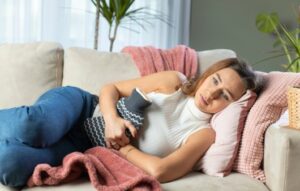Table of Contents
ToggleOverview
Have you fallen prey to vaginal itching, irritation and discharge? Well, you might be having a yeast infection. Yeast infections, also called vulvovaginal candidiasis, are common amongst women. A healthy vagina contains bacteria and fungi. An imbalance between bacteria and yeast can cause the fungus to multiply and result in a yeast infection.
What is a Yeast Infection?
A yeast infection is an infection of the vagina that can cause some uncomfortable and painful symptoms. Yeast infections are common, about 75 percent of women will suffer from a yeast infection at least once in their life, and almost 50 percent will have two or more.
Yeast infections occur most commonly during reproductive years. While they can appear before puberty and after menopause, it is much less common.
Why do Yeast Infections Occur?
Vaginal yeast infection occurs when an overgrowth of the microscopic fungus candida occurs. Your vagina naturally has the yeast Candida microorganism. Usually, the bacteria Lactobacillus keeps its growth in check, but if there’s an imbalance in your system, it can lead to an overgrowth of yeast, resulting in a vaginal yeast infection.
What are the risk factors for getting a yeast infection?
Some risk factors that may lead to a yeast infection include:
- use of antibiotics, which affects the amount of Lactobacillus in the vagina
- weak immune system
- pregnancy
- uncontrolled diabetes
- hormonal imbalance
- stress
Symptoms of Yeast Infections
The symptoms of yeast infections can vary from person to person and from infection to infection. That is why it is so important to speak to a doctor if you are unsure if you have a yeast infection. In addition, yeast infection symptoms can mimic many STDs as well as other vaginal infections.
Some symptoms caused by yeast infections include:
- Redness and swelling of the vulva
- Pain in the vagina, especially when having sex or urinating
- Vaginal rash
- Itching and pain in the vagina and vulva
- Thick white discharge that may look similar to cottage cheese
- Clear, watery discharge
Some people can experience a yeast infection rash, bumps or yeast infection sores due to irritation and discharge.
How are vaginal yeast infections diagnosed?
Candida albicans is a specific kind of yeast that causes most yeast infections. Suppose you’re having yeast infections again and again or have symptoms that are not going away despite using the over-the-counter treatments for a yeast infection. In that case, a different kind of Candida might be causing the infection. In this case, a lab test can identify the specific Candida causing the infection.
Yeast infections are easy to diagnose. Firstly, your physician will take your medical history and history of previous infections. After that, a pelvic exam is done, during which your doctor will examine your vagina, cervix and surrounding area for signs of infection.
Depending on the findings, the next step may be taking a vaginal swab from your vagina. This sample will be sent to a lab for examination. Lab tests are done for a woman with a history of recurrent infections.
How to treat a yeast infection?
The treatment for a yeast infection varies and depends on your current symptoms and medical history. A doctor devises the best treatment plan for you.
Uncomplicated yeast infections:
For uncomplicated yeast infections, your doctor will usually prescribe a 1-6 day regimen of an antifungal cream, ointment, yeast infection treatment pill or suppository. These medications can be in prescription or over-the-counter (OTC) form.
Common yeast infection medicines include:
- fluconazole (Diflucan)
- clotrimazole (Lotrimin)
- butoconazole (Gynazole)
- miconazole (Monistat)
- terconazole (Terazol)
If you have an uncomplicated yeast infection, follow up with your doctor to ensure the medicine has worked.
Complicated yeast infections:
An infection is considered a severe or complicated case if you have:
- redness, swelling, and itching causing vaginal sores or tears
- a history of recurrent infections or more than four infections in one year
- uncontrolled diabetes or a weak immune system
- HIV
- are pregnant
Treatment options for severe yeast infection include a 14-day cream, tablet, or vaginal suppository treatment.
- two to three doses of fluconazole
- long-term prescription of fluconazole taken once a week for 6 weeks or use of topical antifungal preparations for a prolonged duration.
If you have a recurring infection, avoid intercourse and use barrier methods, such as condoms, while having intercourse if you have symptoms of a yeast infection. It is best to discuss yeast infection treatment options with a doctor.
How to prevent yeast infections?
Now that you are more familiar with this annoying and often embarrassing infection, let’s look at how to prevent the symptoms before they begin. Following are 8 ways to prevent yeast infections before they start:
Use Probiotics
Whether you take a probiotic or eat yogurt infused with probiotics, these collections of live microorganisms can have benefits for your vaginal health.
A bacteria called Lactobacillus makes up some of the most common probiotics. This helps to prevent Candida and other bacteria from growing out of control and causing an overgrowth of yeast.
In a recent study, probiotics were shown to be effective in preventing yeast infections in post-menopausal women.
A 2012 study concludedconcluded that a combination of yogurt and honey is an effective alternative medicine in treating yeast infection in pregnancy.
A 2015 study yielded similar results in non-pregnant women, citing the growing resistance to antifungal treatments as the reason to conduct the study.
Switch to Estrogen-Free Birth Control
Yeast infection after starting birth control is very common. Birth control, while essential in the prevention of unwanted pregnancy, can also have an adverse effect on your vaginal health. That is because estrogen promotes the production of more yeast. Therefore, using birth control that contains estrogen may trigger a yeast infection.
If your birth control is causing yeast infections to try progesterone-only pills or an IUD instead.
Wear Cotton Underwear
Yeast thrives in moist warm areas. Underwear made from natural fabrics like cotton absorbs dampness, so your vagina is as healthily dry as possible.
Related: Why Do I Keep Getting Yeast Infections?
Avoid Scented Personal Products
Perfumes, dyes, and scented soaps irritate the inside of your vagina and increase the risk of getting a yeast infection.
Clean the Right Way
Cleanse your vagina regularly and pay close attention to the inside folds because that’s where yeast gathers. Do not use any douche or internal cleansing products, as these can interrupt your vagina’s natural pH balance.
Related: Preventing a Yeast Infection After Sex: Fungal Infection Home Remedies
Use Natural Remedies
Organic cold-pressed coconut oil and garlic are two of the best homemade remedies for yeast infections. Apply the oil as a lotion. The garlic can be consumed Either eat applied to the vaginal directly in the form of a paste. A mild burning sensation can occur after application.
Get Enough Sleep
Restful sleep promotes proper bodily functions. It also keeps the level of acidity in the vagina stable and lowers the rate of vaginal yeast growth.
Related: Is Vagisil Good for Yeast infections?
Eat a Healthy Diet
Limit your intake of sugar, starchy vegetables, meat, and dairy products. Yeast thrives on them, especially on processed and simple sugars.
Some Causes of Recurrent Yeast Infections
Yeast infections are prevalent. According to specialists, yeast infections are possibly the most common type of vaginal infection a woman can get. However, some may never get them, while others could get them very frequently. Recurrent vulvovaginal candidiasis (RVCC) happens when a woman gets recurring yeast infections four times or more in one year.
If you don’t know if you have one, the CDC has laid out the main signs and symptoms of yeast infections. These are exceedingly itchy, tender, dry, and particularly painful vagina during intercourse. In addition, a gooey, clumpy vaginal discharge indicates that you may have a yeast infection.
Experts suggest you visit your doctor when you think you have yeast infections, especially if you have RVCC. You may need to take heavier-duty prescribed medication. The following are some reasons for recurring yeast infections and tips to help alleviate or prevent the symptoms.
New Partner Sex can Cause a Yeast Infection
Women susceptible to yeast infections may have observed signs and symptoms appear after they’ve had sex with a new partner. This is because yeast infections are triggered by an imbalance of the natural environment in the vagina.
Each woman has a distinct blend of different bacteria. When a foreign substance like semen appears, the balance of your pH or vaginal environment is disrupted, resulting in yeast infections. Even personal lubricants can disturb the balance, so vaginal health tips suggest that it would be best to choose unscented and hypoallergenic lubes.
Douching Your Vagina
It’s strongly advised that you don’t do any douching to your vagina. A woman’s vagina is self-cleaning, so there’s no need to clean it in such a way. Douching can disrupt the natural balance that was mentioned earlier.
Some may have grandmothers who advised them to clean with vinegar, but it’s still best not to do that as it can trigger a vaginal imbalance that could result in infections. Even scented soaps and products should be avoided, according to vaginal health tips.
Taking Antibiotics Could Spark More Yeast Infections
Antibiotics are powerful medications that can kill bacteria and treat infections. However, they can also kill the bacteria responsible for suppressing Candida’s growth, causing yeast infections.
Plenty of women have reported a yeast infection after antibiotics. It’s an adverse domino effect that women who have RVCC could experience.
Tight and Synthetic Panties
Underwear made of synthetic materials can result in more sweat, which could accumulate and harbor more bacteria. For women more vulnerable to yeast infections, vaginal health tips suggest that they wear cotton underwear because it’s more breathable.
It still depends on the individual because some athletes who wear spandex daily don’t get yeast infections. So it’s just an added measure you could employ, especially if you sweat more often.
Do You Have Diabetes or Pre-Diabetes?
Blood sugar levels can have severe consequences on the condition of your vagina. Yeast flourishes in environments that have high sugar. As a result, if you have Type 2 diabetes that’s not well managed, you could become more vulnerable to yeast infections.
This could be an added reason for you to have your blood sugar or diabetes under control. General health tips have stated that this can be done via taking medications, exercise, diet, or a combination of all three.
When to Consult A Doctor
Do you have symptoms of a yeast infection? The treatment is simple, talk to one of our doctors and get a prescription within minutes.
FAQs About Yeast Infection Answered by Your Doctors Online
Vaginal yeast infection occurs when an overgrowth of the microscopic fungus candida occurs. Usually, the bacteria Lactobacillus keeps its growth in check. Still, if there’s an imbalance in your system, it can lead to an overgrowth of yeast, resulting in a vaginal yeast infection.
Some risk factors that may lead to a yeast infection include:
use of antibiotics, which affects the amount of Lactobacillus in the vagina
weak immune system
pregnancy
uncontrolled diabetes
hormonal imbalance
stress
A yeast infection can be treated by using antifungal cream, ointment, yeast infection treatment pill or suppository. Many medications are available over the counter, while others require a prescription.
The best way to prevent a yeast infection is to wear loose-fitting clothing and avoid vaginal products such as sprays, powders, or scented pads. If you still develop yeast infection symptoms, you can also start using an antifungal during your course of antibiotics after consulting with a doctor.
Here are some ways that can help prevent a yeast infection in pregnancy:
Keep the vaginal area dry
avoiding warm bubble baths and douches.
wear cotton underwear
eat healthily to leading a healthy immune system and reduce stress
In some cases, due to excessive irritation/itching or in case of complicated infection that causes yeast infection sores, you may notice bleeding.
There are over-the-counter creams and suppositories available that can help cure a yeast infection. For example clotrimazole or miconazlole. In addition, prescription antifungal pills such as fluconazole help cure the infection rapidly.
If you are experiencing swelling, irritation, itching, and white vaginal discharge, it can mean you have a yeast infection.
Being on birth control, excessive use of antibiotics, a weak immune system or uncontrolled blood sugar levels can be some reasons why you may be getting recurrent infections.
Mild infections clear up in a few days. However, severe infections may last up to two weeks or more.
No, it is a fungal infection. Candida albicans is a type of fungus that causes most yeast infections.
Mild infections can clear up independently, but the symptoms often require treatment.
Over-the-counter creams, gels, or vaginal suppositories effectively and safely treat a yeast infection.
Antibiotics are powerful medications that can kill bacteria and treat infections. However, they can also kill the bacteria responsible for suppressing Candida’s growth, causing yeast infections.
Symptoms can vary from individual to individual. For example, a mild infection may not be characterized by itching.







